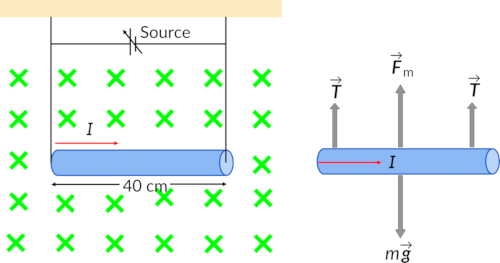28.8: Magnetic Force On Current-Carrying Wires: Example
In a magnetic field, moving charges encounter a force. If a wire contains these moving charges, i.e., if the wire is carrying a current, then a force acts on the wire as well. Consider a pair of flexible leads holding a wire that is 40 cm long and 10 g in weight in a horizontal position. The wire is placed in a constant magnetic field of 0.40 T, as shown in Figure 1(a). Determine the magnitude and direction of the current flowing in the wire needed to remove the tension in the supporting leads.
First, to solve the problem, draw a free-body diagram of the system, as shown in Figure 1(b). Second, use the right-hand rule to determine the direction of the magnetic force acting on the wire. Finally, equate the two forces to determine the current in the wire.

In a free-body diagram, the tension in the supporting leads is zero when the magnetic and gravitational forces are balanced. By using the right-hand rule, the magnetic force points up, and by equating the two forces of weight and magnetic force on the wire:
The current in the wire can be determined. The large magnetic field creates a significant force on a length of wire to counteract the weight of the wire.


